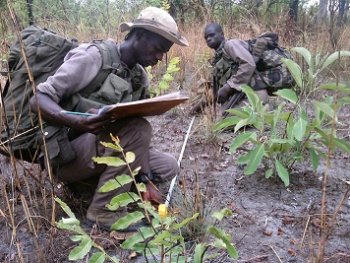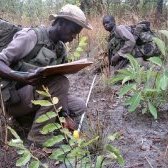
31 May 2018 Foot survey in Bamingui Bangoran National Park
 Manage,
Manage,  The results
The results
Between March 13 and April 8, 2018, a foot survey was conducted in North CAR to assess the status and trends of large-bodied wildlife species and human activities.
This activity is part of the Ecological Monitoring.
- More than 40 rangers covered 1,940 km on four to five-day missions to cover an area of 7,996 km2 in northeastern CAR
- Human impact indices were ubiquitous, with a conservative estimate of 412 shepherd camps with 8,058 head of cattle, 969 poachers’ camps and 82 fishing camps
- The presence indices of the cattle herders are the most numerous. Cattle herders pose a threat to wildlife through direct competition for areas near water sources, grazing, poaching and their intolerance to large carnivores;
- Poachers are more than 97% local. A single meeting with well-armed poachers from Sudan took place at the level of Koukourou-Bamingui, where armed men with dozens of donkeys operate all year round. They are supplied with ammunition and transport their meat in a nearly continuous manner;
- While stressing that the confidence indices of the estimates, expressed in CV%, are high, the most common species, estimated at more than 2,000 individuals in the area of 7,996 km2 recorded in 2018 are: baboon (Papio cynocephalus), derby eland (Taurotragus derbianus), Grimm’s duiker (Sylvicapra grimmia), warthog (Phacochoerus porcus) , hartebeest (Alcelaphus buselaphus major), red-flanked duiker (Cephalophus rufilatus), hippotrague (Hippotragus equinus), Patas monkey (Erytrocebus patas), green monkey (Cercopithecus aethiops), guib (Tragelaphus scriptus) and orbi (Ourebia ourebi).
Species estimated between 2,000 and 100 individuals are:
- buffalo (Syncerus caffer),
- waterbuck (Cobus ellipsiprymnus defassa),
- Uganda kob (Kobus kob),
- lion (Panthera leo),
- leopard (Panthera pardus),
- hyena (Crocuta crocuta),
- black-fronted duiker (Cephalophus nigrifrons),
- blue duiker (Cephalophus monticola),
- black and white colobus (Colobus guereza),
Species estimated at fewer than 100 individuals are (and most likely much fewer than 100) are:
- elephant (Loxodonta africana),
- giraffe (Giraffa camelopardalis antiquorum),
- bongo (Tragelaphus euryceros),
- hippopotamus (Hippopotamus amphibious),
- giant forest hog (Hylochoerus meinertshageni),
- wild dog (Lycaon pictus).
- reed buck (Redunca redunca),
No evidence of sitatunga (Tragelaphus spekeii), damalisque (Damaliscus lunatus korrigum), kudu (Tragelaphus strepsiceros), cheetah (Acinonyx jubatus) or ostrich (Struthio camelus) was recorded in the surveyed area.
